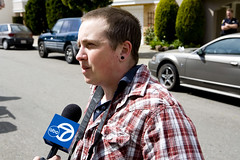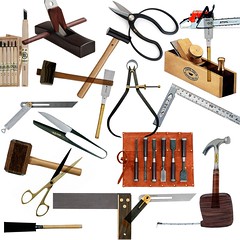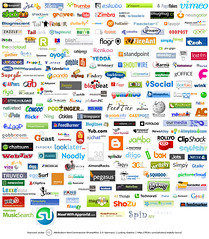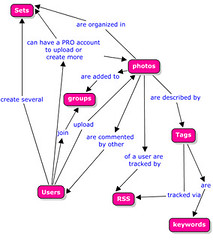Tuesday, April 29, 2008
Is Television (as we know it) Dead?
 Will we continue to watch network television as we do now for much longer? Our society has become more and more used to "on demand" services. Network television doesn't necessarily fill this need. Podcasting and video sharing sites like YouTube started a huge shift in how we take-in our visual (and audio) media. Now services like Joost, Hulu and Fancast are taking this to a new level.
Will we continue to watch network television as we do now for much longer? Our society has become more and more used to "on demand" services. Network television doesn't necessarily fill this need. Podcasting and video sharing sites like YouTube started a huge shift in how we take-in our visual (and audio) media. Now services like Joost, Hulu and Fancast are taking this to a new level.
Step one was taken recently as Warner Brothers' closed down network, "The WB" re-opens online as TheWB.com and KidsWB.com as reported in the New York Times. Many of the major networks already offer viewing of shows online, but WB is taking their network completely online. How long will it take for all television to be network-based? Will it continue to be done similarly to how it is done today?
We live in truly exciting times. A couple of weeks ago at our school's career fair Bill Green, from WCSH NBC TV, mentioned to our students during his keynote that he did not feel network television would exist as it does today within their lifetimes. I don't think it will be all too long from now that we'll see this change. Even Netflix is working with LG Electronics to develop a television that could pull movie rentals over the Internet. What implications will this have for education when all media (yes, books too) will be available to us from our laptops and other mobile devices?
tag: television, future, worthsharing
Image Attribution:
Image: 'one less tv'
www.flickr.com/photos/92518741@N00/24771587
Monday, April 28, 2008
Student Uses Twitter to Escape Egyptian Jail
 CNN ran this story about James Buck the other day which really demonstrates some of the powers of Twitter. James Buck, a graduate student at the University of California-Berkeley, was in Egypt covering protests in Mahalla, Egypt.
CNN ran this story about James Buck the other day which really demonstrates some of the powers of Twitter. James Buck, a graduate student at the University of California-Berkeley, was in Egypt covering protests in Mahalla, Egypt.
He simply tweeted one word using his cell phone, "Arrested."
This got the message out to his followers of this news. According to James Buck, "The most important thing on my mind was to let someone know where we were so that there would be some record of it ... so we couldn't [disappear]," Buck said. "As long as someone knew where we were, I felt like they couldn't do their worst [to us] because someone, at some point, would be checking in on them."
According to James Buck, "The most important thing on my mind was to let someone know where we were so that there would be some record of it ... so we couldn't [disappear]," Buck said. "As long as someone knew where we were, I felt like they couldn't do their worst [to us] because someone, at some point, would be checking in on them."
tag: twitter, worthsharing
Image Attribution:
Map
Courtesy of Google Maps
"James Buck"
http://flickr.com/photos/elhamalawy/2424357188/
Thursday, April 24, 2008
Reflection on Konrad Glogowski's Presentation: Initiating and Sustaining Conversations...
 Any teacher thinking about starting to blog with his/her students should be required to watch Konrad Glogowski's K12 Online Conference presentation, "Initiating and Sustaining Conversations: Assessment and Evaluation in the Age of Networked Learning", and follow it up with Jeff Utecht's session, "Sustained Blogging in the Classroom" (see my reflection on Jeff Utecht's presentation). These two sessions will bring years of experience to any teacher beginning to use blogs as an instructional tool. Both presentations provide many exceptional ways to use blogs as an engaging educational tool and how to keep yourself from merely using blogs as another way to write essays.
Any teacher thinking about starting to blog with his/her students should be required to watch Konrad Glogowski's K12 Online Conference presentation, "Initiating and Sustaining Conversations: Assessment and Evaluation in the Age of Networked Learning", and follow it up with Jeff Utecht's session, "Sustained Blogging in the Classroom" (see my reflection on Jeff Utecht's presentation). These two sessions will bring years of experience to any teacher beginning to use blogs as an instructional tool. Both presentations provide many exceptional ways to use blogs as an engaging educational tool and how to keep yourself from merely using blogs as another way to write essays.
"Grades are definitive pronouncements, they stop conversations."
This statement by Konrad Glogowski is still ringing in my head. If blogging is truly about conversations, we can not assess this work in a traditional sense as we would another piece of writing. Students must be taught that blogging is an evolutionary process. The teacher is key to this evolution. As students get more adept at aspects of their blogging their teacher must challenge them to further develop their skills and depth. If this constant challenge does not occur, student boredom will settle in and their blogging will deteriorate.
I also found this session valuable for myself as a blogger. I continue to attempt to find the time to use my blog as a reflective tool and to continue the conversations from blogs I read, Twitter posts, and other thoughts that occur to me. This presentation made me think of how I want my own blog to evolve. I hope the words I have to say are of importance to others. How will I continue to challenge myself to improve the evolution of myself as a blogger? This presentation gave me some great pointers!
tag: k12online07cl05, k12online07, konradglogowski, jeffutecht
Image Attribution:
Image: 'traffic light reworked'
www.flickr.com/photos/94507863@N00/1288380740
Reflection on Wendy Wolfe's Presentation: If All My Classes Did This
 When I was young, if someone asked for a tool. They were thinking about an implement such as those pictured to the right. It was a device that could help do some manual tasks. When I speak about tools to my colleagues and students I'm usually referring to some of the new tools of Web 2.0 as pictured below (left). Both sets of tools make it easier to accomplish a task. It's time to re-tool our classrooms to be using the tools of Web 2.0 in ways that increase student engagement and provide multiple ways for students to demonstrate their learning.
When I was young, if someone asked for a tool. They were thinking about an implement such as those pictured to the right. It was a device that could help do some manual tasks. When I speak about tools to my colleagues and students I'm usually referring to some of the new tools of Web 2.0 as pictured below (left). Both sets of tools make it easier to accomplish a task. It's time to re-tool our classrooms to be using the tools of Web 2.0 in ways that increase student engagement and provide multiple ways for students to demonstrate their learning. In Wendy Wolfe's K12 Online Conference presentation, "If All My Classes did This", she demonstrated some of the tools of Web 2.0 and how she uses them in her classroom. She specifically demonstrates:
In Wendy Wolfe's K12 Online Conference presentation, "If All My Classes did This", she demonstrated some of the tools of Web 2.0 and how she uses them in her classroom. She specifically demonstrates:
I'm not as thrilled with having students create PowerPoint-like slides in tools like Zoho (or GoogleDocs) that just cram a ton of text onto a slide. I want to push as many teachers who continue to use PowerPoint as their gateway drug into technology integration to see Dean Shareski's K12 Online Conference session, "Design Matters". We must teach students how to create a quality presentation and how to deliver it. These online MS Office-like suites are becoming more and more powerful. I've become a huge fan of GoogleDocs. I actually find Zoho more robust than GoogleDocs and Spreadsheets. However, I like to teach students about many of the other tools that Google offers so I tend to go in the Google direction because I'm such a fan of iGoogle, GoogleReader, GoogleMaps and more. Google Docs and Spreadsheets offers enough of the power I want to push my students in that direction. This limits their need for mulitple sites to log into. Google holds onto their login on each student's laptop which makes it easy for each student to bounce from one Google tool to the next.
I'm really interested in GCast. I just set up an account and posted my first podcast with it using my mobile phone. I interviewed my two daughters on why they love going to Webkinz World. What a great and easy to use tool!
tag: k12online07cl10, k12online07, wendywolfe
Image Attributions:
Image: 'Beautiful Tools'
www.flickr.com/photos/49503154413@N01/100043823
Image: 'LOGO2.0 part I'
www.flickr.com/photos/16851909@N00/93136022
Wednesday, April 23, 2008
Reflection on Frank Pirrone Presentation: Collaborative Concept Mapping
 The students and teachers in my building use concept mapping tools fairly regularly. In the past they have used FreeMind, Gliffy, and Bubble.us. I had heard of CMapTools in the past but had not found the time to learn about this tool. When I saw the K12 Online Conference session offered by Frank Pirrone I decided to change that.
The students and teachers in my building use concept mapping tools fairly regularly. In the past they have used FreeMind, Gliffy, and Bubble.us. I had heard of CMapTools in the past but had not found the time to learn about this tool. When I saw the K12 Online Conference session offered by Frank Pirrone I decided to change that.
Frank Pirrone provides some great screencasts of how to install the software on your computer through creating your first concept map in his K12 Online Conference session. I installed CMapTools on my laptop as I listened to his presentation. The installation was simple and quick once I realized where to click for the download (you must click on icon directly below "Downloaded" and then click on "CMapTools Download Information & Forms"). Otherwise you may use this direct link to their download page.
As I followed Frank Pirrone's instructions I learned the ins and outs of this great tool. I hope to add a CMap Server over the next few days at my school (I submitted a request for the download link). Either way, I see CMapTools becoming a regular tool at Frank H. Harrison Middle School next year. This free tool provides an exceptional alternative to the costly Inspiration. I will seek to add it to our image on our student and teacher laptops for the next school year.
tag: k12online07nt10, k12online07, frankpirrone
Image Attribution:
Image: 'How flickr works ?'
www.flickr.com/photos/98299765@N00/162403710
Reflection on Jen Wagner's Presentation: Webcasting for Educators
 Even though I've had to explain to my wife why I was going to the computer to watch "Women of Web 2.0" live webcast at 9:00pm on Tuesday nights, I've found the explanation well worth the time. I have enjoyed sitting in on a few of the shows over the past 12 months and have found them to be most interesting. The guests they get are always top notch and the hosts (Cheryl Oakes, Jen Wagner, Vicki Davis, and Sharon Peters) do a great job of moderating the discussion and bringing in the conversations from the chatroom. I had the distinct pleasure of actually being around for their only live webcast done face to face at NECC last summer.
Even though I've had to explain to my wife why I was going to the computer to watch "Women of Web 2.0" live webcast at 9:00pm on Tuesday nights, I've found the explanation well worth the time. I have enjoyed sitting in on a few of the shows over the past 12 months and have found them to be most interesting. The guests they get are always top notch and the hosts (Cheryl Oakes, Jen Wagner, Vicki Davis, and Sharon Peters) do a great job of moderating the discussion and bringing in the conversations from the chatroom. I had the distinct pleasure of actually being around for their only live webcast done face to face at NECC last summer.
It was great to see more of the behind the scenes work that is done to make this show so successful in their K12 Online Conference presentation. The discussion and demonstration of the tools that are used in the background to keep the show organized and running smoothly was of tremendous use. The tools most commonly used by the group are:
I had done some webcasting 6 years ago while I was working at Lake Region Middle School using a Macintosh OS X Streaming Server and Live Channel Pro software to stream student presentations. Now tools like UStream.tv bring similar functionality to any desktop for free. I hope to assist some of our students in doing a student led show. Last month WOW2 did a show featuring Alice Barr, Kern Kelley, and some of their students. Several of the students really enjoyed being on the show and would like to start a show of their own. I'd like to be part of helping this happen.
tag: k12online07pn05, k12online07, jenwagner, vickidavis, cheryloakes, sharonpeters
Image Attribution:
Image: 'WOW_3'
www.flickr.com/photos/20819183@N00/638263760
Tuesday, April 22, 2008
Reflection on Jeff Utecht's Presentation: Sustained Blogging in the Classroom
 I have found over the past two years that many educators start having their students write in blogs. As they see the quality of the work and the interest their students demonstrate in their writing for a world-wide audience they get really excited. A few months later, their students are rarely using their blogs if at all.
I have found over the past two years that many educators start having their students write in blogs. As they see the quality of the work and the interest their students demonstrate in their writing for a world-wide audience they get really excited. A few months later, their students are rarely using their blogs if at all.
Why does this phenomena occur? Educators are seeing gains in student writing, students are excited about their writing, and students are providing each other great feedback on their work. What is missing here? If I were to have a booth at the annual NCTE conference and was selling a product that offered these results, I would have a very busy booth.
Jeff Utecht's K12 Online Conference presentation, "Sustained Blogging in the Classroom", sheds some light on this problem. I feel that many teachers who take on blogging with their students view it as an additional thing that has to be added to their day. It is important that teachers look at how they structure their day to use blogging as a tool for student conversation - not merely online journals. Teachers who have sustained blogging with their students in my building have followed many of Jeff's tactics. The most important piece I have seen is the stressing of good comments. Years ago I attended a conference on differentiated instruction and one of the presenters said something tremendously simple but extremely powerful, "If you expect it, teach it." How often do we expect our students to know how to write a good comment that continues the conversation without teaching this skill?
I like the work that Mark Ahlness is doing with the restructuring of his SSR (Sustained Silent Reading) to allow blog reading and other reading of interest to his students. So many teachers feel that students must have a paper book in their hands for SSR time to be valuable. How are we developing a love of reading in children when we do not allow them to choose the subject and media they prefer?
Tips for sustaining blogging with your students (from this presentation and my own thoughts):
- Model what good blogging looks like. Have your own blog and let your students read it.
- Teach your students how to submit comments that extend the conversation started by a blog post.
- Make blogging part of how you teach - not an extra thing. Embed blogging in all of your students work.
- Help your students create their network of bloggers (and other RSS feeds) that they follow.
- Teach your students that blogging is about reading as much as it is about writing.
- Create a rubric of how they will be assessed on their blog. Preferably this rubric would be created with your students.
- Provide students with options of what they write about.
- Make commenting part of classwork/homework. Students need to know the importance of reading and providing feedback to their classmates and the blogging community.
Image Attribution:
Image: 'conversations_silhouettes_id228513_size450'
www.flickr.com/photos/50698336@N00/1411905457
Reflection on Chris Harbeck's Presentation: Release the Hounds

"Don't hold your students back."
This simple quote by Chris Harbeck in his K12 Online Conference presentation is one of the hardest concepts to get many teachers to buy into. I find the most successful teachers who truly leverage technology to improve student engagement on a cognitive level provide their students options in how they demonstrate their learning. All too often, teachers do not want to allow their students to use tools they do not know themselves. Let your students learn tools that excite them. They will teach you and their classmates how they use them in their learning. Chris Harbeck demonstrated this beautifully with specific examples from his classroom.
I remember a conversation I had last year with one of the teachers in my building as she started using wikis in her classroom. She was excited about the learning that was taking place in her classroom and the excitement the students demonstrated in their learning. As she mentioned this, she also mentioned that she felt strangely about it since she "wasn't teaching" (in a traditional sense).
My question to her was a simple, "Are the students learning?"
Her quick reply, "yes and more."
Teachers need to provide freedom to their students to take ownership of their learning. This doesn't necessarily mean just sending them off to their laptops to randomly do work while the teacher corrects prior student work at her desk. Students need clear guidelines of what you expect from their work and guidance of how to get there. As the students progress in their work have them teach you the tools they are using to demonstrate their learning. We can all learn more this way.
tag: k12online07cl06, k12online07, chrisharbeck
Image Attribution:
Image: 'Push The Button'
www.flickr.com/photos/12949199@N00/349222636
Reflection on Dean Shareski's Presentation: Design Matters
 As I watched Dean Shareski's presentation I found myself thinking about the past 6 years of working in one to one computing environments and how the addition of one to one has changed the design of classrooms. I'm often asked what I see as the biggest change that one to one computing has brought to teaching and learning. My first response is always "collaboration". When I walk into a classroom it is a different experience than it was 5-6 years ago. First of all, it can be very difficult to locate the teacher. They are not typically in the front of the classroom. They are much more commonly found sitting with students or on one knee beside a student guiding the learning that is taking place in their classroom.
As I watched Dean Shareski's presentation I found myself thinking about the past 6 years of working in one to one computing environments and how the addition of one to one has changed the design of classrooms. I'm often asked what I see as the biggest change that one to one computing has brought to teaching and learning. My first response is always "collaboration". When I walk into a classroom it is a different experience than it was 5-6 years ago. First of all, it can be very difficult to locate the teacher. They are not typically in the front of the classroom. They are much more commonly found sitting with students or on one knee beside a student guiding the learning that is taking place in their classroom.
The majority of classrooms in my building have changed from the Industrial Age model of desks in neat rows and columns to groups of desks (or tables) to more of a Information Age design with desks (or tables) in grouped patterns. Many of these classrooms change their design from day to day based on the task being completed. Despite the desks not being bolted to the floor, it amazes me how many classrooms never change their set up of desks and chairs.
Clarence Fisher's analogy of "classrooms as studios" really hit me as I think about the ramifications of a studio workspace versus a traditional classroom. His point of students all painting the same line in the same way sounds ridiculous in a studio environment. Why isn't it just a ridiculous in a typical classroom environment? It makes me think of how David Warlick often describes the work he did in his Industrial Arts classroom as a student. The projects he completed in this class had him use tools to create - not learn the about the tools. If we want our students to use the tools we need to have them create with them - not merely learn about them. If they create using the pointers by Dean Shareski they will produce compelling projects with true "visual literacy".
tag: k12online07cl09, k12online07, deanshareski
Image Attribution:
Image: 'Chairs'
www.flickr.com/photos/89898604@N00/6550520
Monday, April 21, 2008
Reflection on Sharon Betts' New Tools Presentation: Oodles of Googles
 I have spent some time this year exploring the options that Google can provide an educator using Google Apps with a custom domain. I continually enjoy the resources that Google offers free to educators. I do an entire session on Google Tools for my course at Saint Joseph's College. The vast majority of my college students do not realize how much more can be done at Google beyond searches for information and images.
I have spent some time this year exploring the options that Google can provide an educator using Google Apps with a custom domain. I continually enjoy the resources that Google offers free to educators. I do an entire session on Google Tools for my course at Saint Joseph's College. The vast majority of my college students do not realize how much more can be done at Google beyond searches for information and images.
I have not used Web History in the past. Part of me thought is was just a bit odd to keep that information up on the Google servers. I see how it could be used to log your travels during a research project and as a way to keep track of sites, but find that Delicious works well for me in that arena (without the privacy issues).
I have used the Notebook feature in the past. I never realized how you can drag and drop images and text into your notebooks so easily. What a great way to organize your information! I have my students use Google Docs to collaborate on work for the course. They really like the change from sharing several copies of a document with each other to sharing one document with several people.
I definitely will need to spend some time exploring Google Groups. This looks like it could be a great resource for me and my students to use in the future. The ease of sharing information, files, and more appears as though it will be truly beneficial.
tag: k12online07nt03, k12online07
Image Citation:
http://theithacan.org/blogs/brink/files/2007/11/google.jpg
Reflection on Derek Wenmoth's Keynote: Holding a Mirror to our Professional Practice
 Reflection has always been hard for me in my own professional practices. I have been trying to use my blog as a tool for this in the past. Time tends to become the biggest obstacle for me. I tend to spend my time looking forward more than looking behind. I just tend to find it a little more murky when trying to reflect in a formal manner. Most of my reflection is done in informal ways. Moving forward may be a bit more efficient if my forward movement is guided by a well planned and executed reflective practice. Placing a mirror to my practices more often would be beneficial.
Reflection has always been hard for me in my own professional practices. I have been trying to use my blog as a tool for this in the past. Time tends to become the biggest obstacle for me. I tend to spend my time looking forward more than looking behind. I just tend to find it a little more murky when trying to reflect in a formal manner. Most of my reflection is done in informal ways. Moving forward may be a bit more efficient if my forward movement is guided by a well planned and executed reflective practice. Placing a mirror to my practices more often would be beneficial.
As a response to this I would like to answer the questions posed by Derek Wenmoth in his K12 Online Conference Keynote, "Holding a Mirror to our Professional Practice".
1. What are the mirrors you hold to your professional practice?
The mirrors I use in my professional practice are mostly done directly after an event. I often will do an internal debrief after I have provided a workshop, taught a class, or presented in front of a group. I find the drive home to be a great quiet time for me to accomplish this. If I have the opportunity to request feedback from colleagues after an event I do that as well. Fortunately, I am part of a great team of Instructional Technology Integrators in the Yarmouth School Department. We always debrief together after we provide a professional development session.
2. Who are the mentors you relate to on a regular basis?
My main mentors would be my district team mates in our technology department. We often provide our district professional development as a team. Alice Barr and Cathy Wolinsky serve as mentors to me in this capacity. Their support helps me improve my work.3. What professional reading do you do?
I read a lot of blog entries that come into my RSS aggregator as well as through my Twitter timeline. I also read professional books to continually improve myself. This year I have read (links are to Amazon listings of the books):I am just starting Wikinomics by Don Tapscott
- The Art and Science of Teaching by Robert Marzano
- A Whole New Mind by Daniel Pink
- Classroom Blogging: 2nd Edition by David Warlick
4. What communities of practice do you belong to - online or face to face?
My communities of practice combine online communities and face to face. As I mentioned earlier, Alice Barr and Cathy Wolinsky provide me a tremendous face to face community to provide me feedback and to share our learning. My online community is mainly fostered through Twitter (username: marsenault). I have really found this to be my most powerful and immediate community for information and feedback. I also participate in the Seedlings Ning site. This is an online community started by Alice Barr, Cheryl Oakes, and Bob Sprankle to support educators in their use of technology.5. Do you have a blog where you record your ideas, thoughts, and reflections?
Yes. I have tried using a few different blog engines. Most of my work has been done in the past at an Edublogs blog I had set up. I didn't find that I used that tool enough. I have tried setting up this blog this year using Google's Blogger engine with a custom domain to use blogging more for reflective purposes.6. What RSS feeds do you subscribe to in order to keep abreast of current thinking?
I subscribe to many RSS feeds to keep current. Check them out at my public Bloglines page.7. When did you last visit someone else's classroom to observe and feed back?
This is something I do not typically do. I do find myself in other teachers classrooms from time to time. When I am in the classroom with other teachers I am usually there as a co-teacher. My position does allow me the flexibility to work with many of the teachers within my building. As I work with these professionals I do get to see a variety of teaching styles which influence my teaching.8. When did you last present in a workshop, to a staff meeting, or a conference?
Due to my job, I present in workshops throughout the year in my district. Since moving to my position in Yarmouth I have not presented at any conferences. I am scheduled to present during two sessions at our state-wide technology conference in the fall. I will be participating in a technology integration round table discussion with Joshua Sturk and Laura Richter. I will also be doing a session geared for the pre-service teachers that attend the conference.Image Attribution:
Image: 'still paddling'
www.flickr.com/photos/61779926@N00/169150970
tag: k12online07, k12online07pn01
Friday, April 18, 2008
Reflection on Brian Crosby's Keynote: The Why's and Wherefores
 We just started our April vacation today and I'm using my vacation time as a chance to catch up on my work for the K12 Online Conference graduate course. I was worried that I needed a chance to get some time off to recharge the batteries for the end of the year. After watching Brian Crosby's Obstacles to Opportunities keynote I feel like I could change the world! This presentation was tremendously inspiring to watch and think about how teachers can remove the obstacles they put in the way of integrating technology into their classrooms. I particularly loved how he made it clear that it isn't an "add-on". I just wish I wasn't here all by myself today so I could have shared this with other people in my building right now.
We just started our April vacation today and I'm using my vacation time as a chance to catch up on my work for the K12 Online Conference graduate course. I was worried that I needed a chance to get some time off to recharge the batteries for the end of the year. After watching Brian Crosby's Obstacles to Opportunities keynote I feel like I could change the world! This presentation was tremendously inspiring to watch and think about how teachers can remove the obstacles they put in the way of integrating technology into their classrooms. I particularly loved how he made it clear that it isn't an "add-on". I just wish I wasn't here all by myself today so I could have shared this with other people in my building right now.
I use all of the tools that Brian mentioned in my course and with the teachers I work with in professional development sessions. I often refer to my job as being much like a sales position. A good salesman finds the objections a client has and does his best to remove those objections. As a technology integrator and professor I find myself doing the same thing with technology use in schools. Finding the hook that will capture someone into seeing the benefits of technology use in their classroom is what I seek at all times. Removing objections is my job!
I find students enjoy using digital video in their presentations. They learn so much and to quote one of Tim Tyson's former students (from a Karen Janowski tweet as I was writing this post), "Making movies is like learning, on steroids". This is especially true when students create these projects for authentic audiences. Posting your student work to the web through a school website, podcast, or YouTube gets their work out where it can be viewed and commented on by thousands of people. If we get out of the way of our kids learning, they will do tremendous work.
Image Citation:
Captured from Brian Crosby's K12 Online Conference Presentation - The Why's and Wherefores
tag: k12online07oo01, k12online07, briancrosby
K12 Online Conference "More Than Cool Tools" Keynote
 All three presenters in this session provided great insight to some of the tools available in our Web 2.0 world and the benefits of their use. I particularly found Alan Levine's piece of tremendous use for me. Alan Levine shared his "50 Ways to Tell the Dominoe Story" in this presentation. What a great resource! I will be using this resource with teachers that are looking to use some of these tools in their classrooms as well as my course for pre-service elementary education teachers at Saint Joseph's College.
All three presenters in this session provided great insight to some of the tools available in our Web 2.0 world and the benefits of their use. I particularly found Alan Levine's piece of tremendous use for me. Alan Levine shared his "50 Ways to Tell the Dominoe Story" in this presentation. What a great resource! I will be using this resource with teachers that are looking to use some of these tools in their classrooms as well as my course for pre-service elementary education teachers at Saint Joseph's College.
I have used some of the tools Alan describes in the past but really enjoyed seeing some examples of the other resources I was not familiar with. Digital Storytelling is a topic many of the teachers I work with are interested in. This will provide them and their students many ways to demonstrate their work. It is particularly useful that Alan included notes on each tool.
I find myself trying to get more and more of the work that I do, as well as my students and colleagues, online in places where they may be shared. I have found GoogleDocs and Wikispaces to be great tools for this. I have moved my "Technology In Education" course from WebCT to a Wikispace wiki. All of my students at SJC do their course reflections and more on blogs hosted by Uniblogs. It is amazing to see how the students react to comments that occasionally come in from people they are writing about. It creates some tremendous teachable moments for them as they see how the power of RSS truly shrinks their world.
tag: k12online07nt01, k12online07, alanlevine
Clarence Fisher: Classroom 2.0 Keynote
 "Geography is becoming irrelevant"
"Geography is becoming irrelevant"
This comment by Clarence Fisher really stuck with me as I watched his K12 Online Conference Keynote for Classroom 2.0. It's not that the statement is so earth shattering for me, but more because so many schools put their heads in the sand when it comes to that simple statement. The greatest asset that technology has brought to schools in my opinion would be connections. Technology connects us to information, people, and places. These connections can be down the hall or around the world.
I'm in my 6th year working in one to one environments in the State of Maine and it still amazes me that so many schools in my state do not allow students to use (or provide them) email let alone many Web 2.0 tools. When I am asked what has changed the most in classrooms due to one to one computing my first response is always "collaboration". One to one access allows instant collaboration between students, teachers, the community and the world. Classroom 2.0 is definitely about collaboration. The tools that Clarence mentioned (wikis, blogs, voicethread, and more) are all about collaboration, communication with an authentic world-wide audience, and sharing. I also would like to thank the folks at Edublogs, Wikispaces and Voicethread for providing access to teachers to use these exceptional tools for free.
If we going to provide our students an education that prepares them for their future they must have the tools they will use in their future. Students must be taught how to work collaboratively with others near them as well as from away. When we teach those skills geography becomes completely irrelevant. Clarence's students can collaborate with students from around the world and make geography irrelevant. Many schools that provide tremendous access to technology in their classrooms leave their kids "in the bush" as Clarence's students would say because they squelch connections. That is a shame in today's information landscape.
Image Citation:
Image: 'Released to Public: Sinai Penninsula and Dead Sea from Space Shuttle Columbia, March 2002 (NASA)'
www.flickr.com/photos/39735679@N00/491430005
tag: k12online07cl01, k12online07
Thursday, April 17, 2008
Death By PowerPoint
Our annual Career Fair occured at my school this week. I like to get around at events like this and take pictures to post to the school Flickr account and web page. As I cruised around during the last session of the Career Fair I noticed some consistent occurances.


- Presenter connected with the kids by speaking with them (not to them).
- Presenter used visual aides (pictures, models, tools, and more) to help students understand.
- Presenter posed questions to the students to get them involved in the presentation.
- Presenter used slides that supported what they were saying - not slides that were what they said.
- Presenter showed passion for their profession.
Here are some great resources for presenters (and teachers) to use as they think about how they present information to students as well as other audiences.
Life After Death by PowerPoint by Don McMillan
6 Do's to Open Your Presentation by Bert Decker
Better Beginnings: How to Start a Presentation, Book, Article... by Kathy Sierra
How to Give a Great Presentation by D. Keith Robinson
Seven Steps to Better Presentations by Jeffrey Veen
Anything at Presentation Zen
tag: student engagement, presentations
Monday, April 14, 2008
NE Tweet Up: April 13, 2008
 Thank you Liz Davis for organizing this event. I truly enjoyed meeting all of the people who joined us at The Grog Restaurant in Newburyport, MA. The Grog didn't have wireless access so we ditched our laptops and enjoyed plenty of grog ;-).
Thank you Liz Davis for organizing this event. I truly enjoyed meeting all of the people who joined us at The Grog Restaurant in Newburyport, MA. The Grog didn't have wireless access so we ditched our laptops and enjoyed plenty of grog ;-).
We hope to have another meeting of the New England EdTech Twits soon. Liz is now looking into arranging a follow up to Educon to occur around the BLC Conference in the Boston area this summer.
Thank you Alice Barr for sharing your photos.
The group included people from Maine, New Hampshire, Massachusetts, and Connecticut. Hopefully more of New England can be represented next time we get together.
Front Row: Beth, Alice, John, Steve
Back Row: Karen, Maria, Beth, Colleen, Liz, Linda, Sonja
Way Back: Mike, Mike
tag: netweetup
Tuesday, April 1, 2008
April Fools
When I was checking out my Google Calendar this morning I noticed a new feature...
What's new with Google Calendar
Just launched!
Wake yourself up with our new Google Wake Up Kit!
Do you have trouble getting out of bed in the morning? We do, too. In fact this problem became so serious at times that it sometimes resulted in lacklustre attendance at team meetings. To help solve the problem we've created an innovative solution called the Google Wake Up Kit.

"I could never wake up on time to get to our team meetings. But thanks to the new Google Wake Up Kit, I'm always on time now!"
Pedro C.
In combination with the kit, you can receive a new type of notification from Google Calendar, called the "wake up" notification. This notification is relentless in ensuring your timely awakening from restful slumber.





